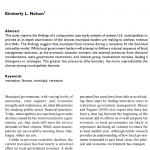Author: Kimberly L. Nelson

Municipal Choices during a Recession: Bounded Rationality and Innovation
This study reports the findings of a comparative case study analysis of sixteen U.S. municipalities to
provide an in-depth examination of the choices municipal leaders are making to address revenue
shortfalls. The findings suggest that municipal fiscal choices during a recession fit the bounded
rationality model. While local government leaders will attempt to follow a rational sequence of fiscal
management decisions, as the economic situation worsens, the external pressures from electoral
considerations, state government restrictions, and interest group involvement increase, leading a
divergence in strategies. The greater the pressures (the bounds), the more unpredictable the
choices among municipalities become.
Cite as:
K. L. Nelson, (2012). “Municipal Choices During a Recession: Bounded Rationality and Innovation”
…
Continued
Municipal Choices during a Recession: Bounded Rationality and Innovation
This study reports the findings of a comparative case study analysis of sixteen U.S. municipalities to
provide an in-depth examination of the choices municipal leaders are making to address revenue
shortfalls. The findings suggest that municipal fiscal choices during a recession fit the bounded
rationality model. While local government leaders will attempt to follow a rational sequence of fiscal
management decisions, as the economic situation worsens, the external pressures from electoral
considerations, state government restrictions, and interest group involvement increase, leading a
divergence in strategies. The greater the pressures (the bounds), the more unpredictable the
choices among municipalities become.
Cite as:
Nelson, Kimberly L. (2012). Municipal Choices During a Recession: Bounded Rationality and Innovation.
…
Continued
Form of Government Still Matters: Fostering Innovation in U.S. Municipal Governments
Using data on the adoption of e-government, reinventing government, and strategic practices, and
the Nelson and Svara (2010) typology of municipal government form, the authors investigate the
characteristics of municipal governments that are related to the implementation of innovative
practices. The authors find that higher innovation rates are associated with council-manager
governments—both with and without an elected mayor, higher population, greater growth,
lower unemployment, sunbelt location, and higher population density. Controlling for all other
variables, form of government (and variations within form) account for the greatest explanation
of the adoption of innovative practices in municipalities. The authors conclude that form of
government remains an important variable to consider when investigating local government
management and performance.
Cite as:
Nelson, K.L. and Svara, James H. (2012). Form of Government Still Matters: Fostering Innovation in U.S. Municipal Governments.
…
Continued
State Level Autonomy and Municipal Government Structure: Influence on Form of Government Outcomes
A number of recent studies have argued that municipal governments have so significantly modified elements of their form of government that it is now difficult to distinguish form. However, none of these studies considers the influence of state government on these choices. This study uses a comprehensive data set of U.S. municipal governments with populations of at least 10,000 and a data set of state legislative provisions related to form of government to investigate the influence of state law on municipal form of government choices. The findings demonstrate that state law is associated with some choices of government form and that structures that hybridize the council-manager and mayor-council forms of government are still relatively uncommon.
Cite As:
“State Level Autonomy and Municipal Government Structure: Influence on Form of Government Outcomes.” American Review of Public Administration, 41 (5): 542-561. K. L. Nelson, 2011.
…
Continued
Conflict and Cooperation in Municipalities: Do Variations in Form of Government Have an Effect?
One measure of governance quality is the level of reported conflict and cooperation that is present between and among elected officials and administrators. High levels of conflict or low levels of cooperation can hinder the decision-making process. However, there are few attempts to assess the causes of conflict and cooperation in the existing literature. This study uses an expanded typology of local government form and additional independent variables to determine what factors are likely to lead to conditions conducive to cooperation and lower perceived conflict in the local governance process. Data on government performance and indicators of perceived conflict and cooperation were collected from a national survey of municipal mayors, council members, and chief administrators in cities with populations of 50,000 to 250,000. Our results suggest that form of government and proportion of council members elected by district are two factors that significantly influence governance at the local level.
Cite as:
Nelson, K. L., & Nollenberger, K. (2011). Conflict and Cooperation in Municipalities: Do Variations in Form of Government Have an Effect? Urban Affairs Review, 47(5), 696–720. https://doi.org/10.1177/1078087411409129
…
Continued
